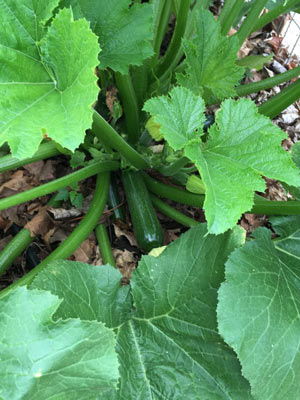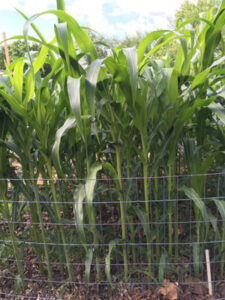The Self-Sufficient Garden Project
In Just Grow It Yourself I related my experience of living for a month only on vegetables produced from my garden. Based on meticulous records of every ounce I consumed over those 30 days, and how much area it took to grow it, I calculated that with a garden of 35’ x 40’ I could grow enough food to keep me alive and healthy for a year.
But as you can see from reading that chapter, predictions don’t always pan out. For instance, I thought that every day I would eat one portion each of corn, winter squash, potatoes, sweet potatoes, leafy greens, tomatoes, and green beans, and two portions of butterbeans—nine portions in all. I did consume nine portions per day, but much more of corn and beans than other items, just because that’s what my appetite preferred.
Nevertheless, I did plan out my 2021 garden based on that experiment, and it is now growing out. Of course, I added some new vegetables, and some different varieties of those I grew the last time, simply because I thought it would get boring to eat only eight different vegetables for a year. So we’ll see if indeed it will produce enough to supply me with a year’s worth of food. It will definitely be exciting if it does (as I expect), given that half of the garden this year is newly-transformed lawn, with much of it having barely four inches of topsoil spaded and forked with amber-colored subsoil. I did add a good bit of good-quality compost, but still.
The following two blog posts are a progress update and a final update after my November harvest. Garden Update September 5, 2021 and The Results are in!
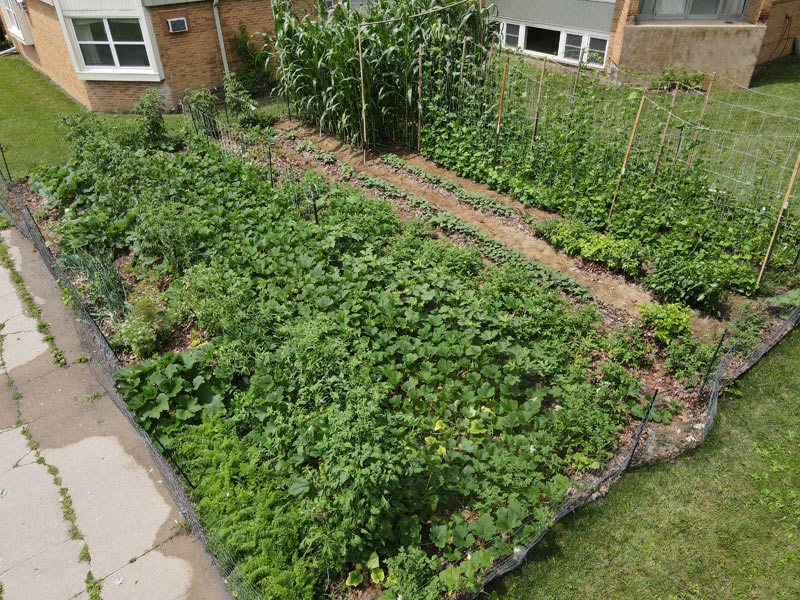
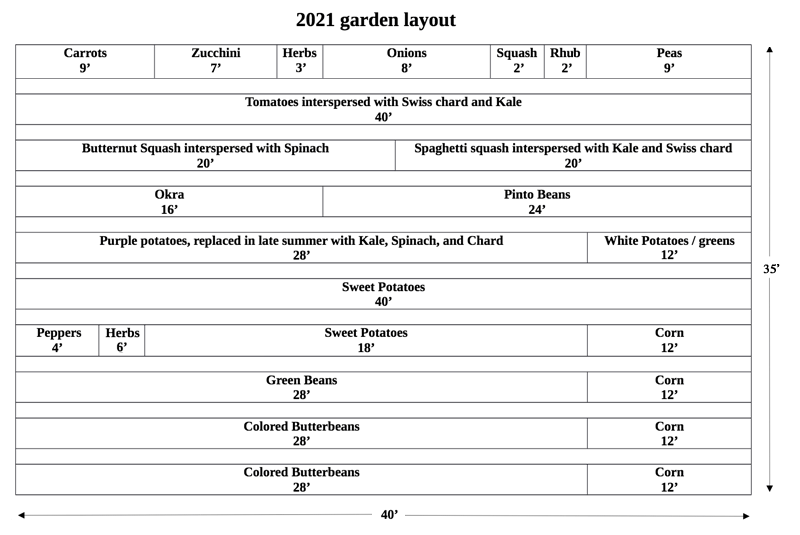
As in the 30-day garden experiment, the idea is to have two parts calorie-rich to one part calorie-sparse vegetables. Or, at a finer resolution, daily 6 portions of energy-rich veggies (e.g., corn, beans, potatoes, etc.) to 3 portions energy-sparse items (e.g., tomatoes, leafy greens, okra, and the like). With, of course, the understanding that they’re all nutrition rich. So for instance, my goal is to grow enough leafy greens (spinach, chard, and kale) to consume one portion of one meal every day, or 365 portions altogether. Already I have grown, harvested, and put up (frozen) 198 portions of greens, which is enough to last me a little over six months.
What follows is the status as of June 25, going left to right and from top to bottom of the garden plan, which faces south (because that’s the location of the sun, which energizes everything).
Row 1
Carrots
Bushy and healthy-looking. Since I expect to store them in the soil where they were growing, I chose a variety called Giants of Colmar (Territorial Seed Co.), which are supposed to get up to a foot long and be harvestable well through the winter. That is, generously covered with mulch to keep the upper layers of the soil from freezing so solid you can’t pull them up.

Zucchini
At the moment my crop of this garden favorite consists entirely one “Green Zucchini” plant. There is room for another, but my neighbor asked if I would plant one of his daughter’s Indian zucchini seedlings. I did, but it got such a late start I don’t think it’s going to do much. Meanwhile the main plant is a four-foot wide luscious monster.
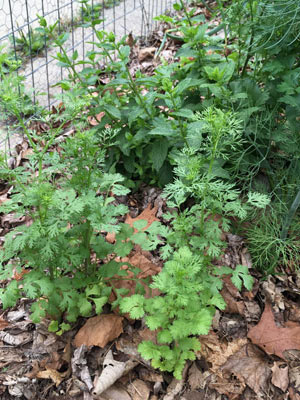
Quite a collection: basil, thyme, oregano, sage, parsley, dill, rosemary, cilantro, savory, and more that are not shown here. I have another little patch of them in row 7.

Mostly red, some yellow, planted from marble-sized starts bought at “Bob’s Barn,” a local sundry food goods and seed store. I’ll use them mostly in tomato sauce.

Not quite as robust as the zucchini plant, this plant nevertheless seems intent on producing just as well. My wife and I could not eat more of them than what one zucchini and one yellow squash plant put out at a given time, and I don’t know of any good way to preserve them. Pickling? Freezing? Canning? Sliced and dried in a tabletop food drier? I think this is one vegetable you just have to eat fresh, and when it’s gone, it’s gone. About the only thing you could do is plant at about 2-3 week intervals, so you have a new plant beginning to produce when the previous one gives out. Maybe I’ll do that next year.
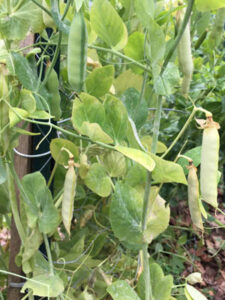
These are not primarily for fresh, early spring eating, although we did try out a few of them, and they were certainly good. Mainly, they’re a special variety (Alaska Early; Territorial Seed Co.) that’s good for harvesting dry for split peas. I love split pea soup, and anything that’s tasty, calorie-rich, and stored dry is a plus, so I thought I’d give them a try. Turns out that by late June they’re pretty much done, which means that very soon I’ll be taking them out to make room for the winter squash vines heading their way. Fast.
Row 2
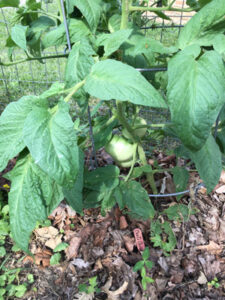
I planted these at three-foot intervals, interplanting with Swiss chard and Siberian Russian Kale. By late June the tomato plants had pretty much overgrown the greens, just as I’d thought they would, but by then I had harvested quite a bit of chard and kale. I tend to favor pink Brandywines, along with a couple of the dark yellow varieties, not only because they taste so good fresh but also because they make the best tomato sauce.
Row 3
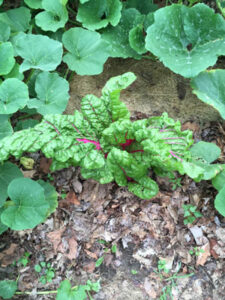
At first, remembering that the previous year my Red Kuri squash had been decimated by squash vine borers, I thought I’d play it safe and just plant Butternut for winter squash, since it’s very tasty, stores well, and is immune to the borers. But then I found some Wisconsin-grown, yellow-fleshed spaghetti squash in the local whole foods store that I liked much better than the usual white-fleshed spaghetti squash, so I saved some of their seeds and planted half the row with them. Man, they’re going bonkers, producing a jungle of vines and lots of squashes. They’re even more vigorous than the butternut, itself no second-rate producer.
As with the tomatoes, I interplanted the squash with spinach, chard, and kale. By the end of June, the squashes had pretty much overgrown them. I show these pictures to illustrate their interspersion with the squash, but as I mentioned I’ve already gotten 197 portions of leafy greens frozen, which is over six months’ worth at the rate of 5 oz per day. By the time I harvested them, the chard leaves were often over a foot wide and long, with the kale almost as large.
Row 4

Sixteen feet of Hybrid Gurney’s Gumbo. My plan here was to plant them next to the winter squash, knowing that the squash vines would run over onto the okra, which would grow fast enough to rise above the squash. However, so far they’ve just barely been able to keep their leaves above the squash. They’re supposed to get four to six feet tall, so eventually they won’t be bothered by the squash along the ground.
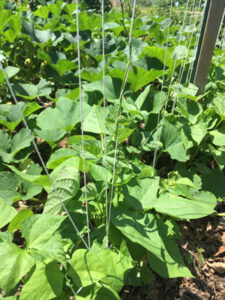
Twenty-four feet, from Urban Farmer. I’d never grown pinto beans, but I really like them and wanted something besides my standby colored butterbeans for dried beans. Pintos are what Mexican refried beans are made of, and they have more fiber than any other kind of bean, for some reason. Not that that’s a big selling point for me, I just like the flavor, and the fact that they take less time to cook than many other dry beans. They’re described as “half-runners,” meaning that they may climb up a support like pole beans, but only a couple two or three feet. So I provided strings to that height, and a couple of them have vines already starting to climb.
Row 5
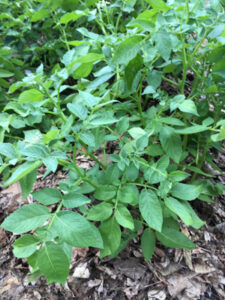
My favorite potatoes have been the all-purple (that is, fully purple-fleshed) for some time, but in two previous tries I didn’t have much luck growing them. This year I initially planted some golf ball-sized all purple potatoes I found the in the whole foods market, but then I decided to go with Purple Majesty (Gurney’s), since they looked like they’d be so much larger. So I dug up the small purples (which hadn’t sprouted yet) and threw them on the compost pile. I then planted 28 feet of the Purple Majesties, but they came , but they came up only here and there, and those that did looked sickly, quite a disappointment.
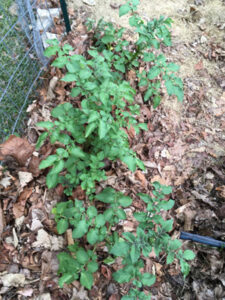
Then, to my even greater surprise, I went to add some kitchen scraps to the compost pile one day and discovered that those golf ball purples had sprouted quite vigorously. So I thought, okay, if you want that much to grow, who am I to hold you back? I then pulled them out of the compost pile, transferred the compost (which wasn’t even particularly well-decomposed) along the east side of the garden fence, right on top of the grass, settled the potato sprouts down into it, and mulched them heavily with wet, dense leaf mulch.

Row 6
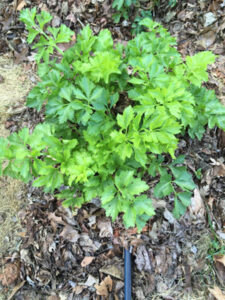
Just four feet of row, since I’ve never grown them before, and have read that they’re difficult. I went to quite a bit of trouble to dig a one foot hole, make a mix of equal parts soil, sand, and compost, and mound it up before planting starts I’d bought at the farmers market. After a couple weeks I mulched them heavily with leaves, then after the stalks appeared to be elongating I piled up even much more leaf mulch, real cozy, because I’d heard that otherwise they’ll form only skinny or short celery stalks. I use celery almost entirely in tomato sauce.
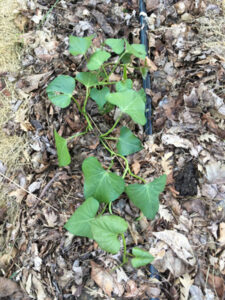
All Beauregard, the one with orange flesh and a pink skin. They like plenty of heat, that is 80s and 90s, so this year I planted the slips—some of which I’d grown from last year’s crop—close to the end of June. But then we had a cold front move in, with temperatures predicted to get into the 40s at night for several days, and possibly one night even into the high 30s. I’d read that that can ruin sweet potatoes, so I dug them up, put them back into their damp sand in pots in the south windowsill, and waited until the front had moved on. Then I replanted them. They’re doing fine now, and I know the vines will spread out into a dense mat. I hope I don’t have voles again this summer, because they like sweet potatoes as much as I do. So far I haven’t seen any signs of them.
Note: the west end of rows 7-10 are planted with 12 feet of corn, to be described shortly.
Row 7
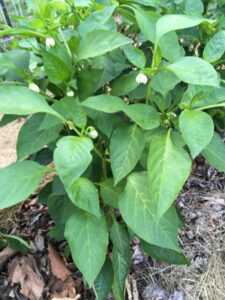
Started these from seed indoors in my little window-box greenhouse that I built to jut out of a south-facing window. “Wonder Bells” from Territorial Seed Co., they’re doing fine, and already have a few fruits almost big enough to harvest. I use them for tomato sauce and, when red-ripe, to dice up and freeze for adding to any number of dishes. I also added a few feet of basil and other herbs next to the peppers, as I’d mentioned previously. The rest of the row, up to the corn, is more sweet potatoes.
Row 8, east end
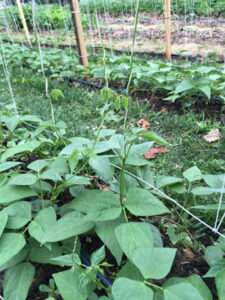
Last year I planted Kentucky Wonders, which are tasty but have those pesky strings if you happen to leave them on the plant just a little too long. Then you have to pick them out of your mouth like fine fish bones, not too pleasant. So this year I planted some Limka Romano (Territorial Seed Co.), which are meaty, long, flat green beans. I’d gotten a few of them at the farmers market last year and really liked them. Alas, only a very few came up, so I had to replant with a different variety; I chose Blue Lake, which I got at the local seed store. Even they didn’t all come up, and they were a couple weeks late. A passerby told me she was already picking her green beans, while mine had barely begun to climb their strings. The result: garden envy.
Rows 9 and 10, east end

This heirloom variety takes up 28 feet of the east end of these two rows. Speckled with various shades of purple, violet, brown, black, amber, off-white, and white, they are basically a kind of lima bean that have been handed down and planted in our family for over a hundred years. Occasionally I see something like them in some seed catalogues, but not often; I once send some of them to Seed Savers Exchange. For some reason the germination rate this year was not so good, so I had to replant in the gaps. But now they look fine, and are beginning to climb up their strings.
Rows 7-10, west end
Corn
“Bloody Butcher” (I didn’t name it) heirloom corn, which can reach 10-12’ tall (literally as high as an elephant’s eye). Corn has to be planted in a block, with at least four adjacent rows ten feet long to ensure good pollination. It’s my favorite vegetable (technically, a grain) but also the most challenging to grow. I have to protect it from chipmunks, crows, raccoons, deer, field mice, flycatcher birds, and fierce summer thunderstorms that can knock it down. But then, it’s sooo tasty and rewarding to eat. Not as sweet corn, which I get at the farmers market, but mainly as grits. I let the ears dry on the stalk, harvest and shuck them, shell off the kernels, then grind them with a hand grain mill and sift the particles out into grits and cornmeal. I saved the four largest, longest ears from my last planting (2019) and planted the four rows each with kernels from a separate ear.
In the book I mention that I planted my 2019 corn crop with 4 feet between rows and 8-10 inches between plants in a row, and discuss how with spacing as close as commercial corn (2½ feet between rows, 6” between plants in a row) I would have gotten a good bit higher yield than the industry average. But then one of my reviewers said, “Prove it.” However, I think spacing of 2 ½ feet and 6 inches is too close. So I planted double rows 3½ feet apart with 8” between any two plants. So far it’s been growing like gangbusters. It will be interesting to see if the yield rate exceeds the national average for corn. I’m betting it will.

